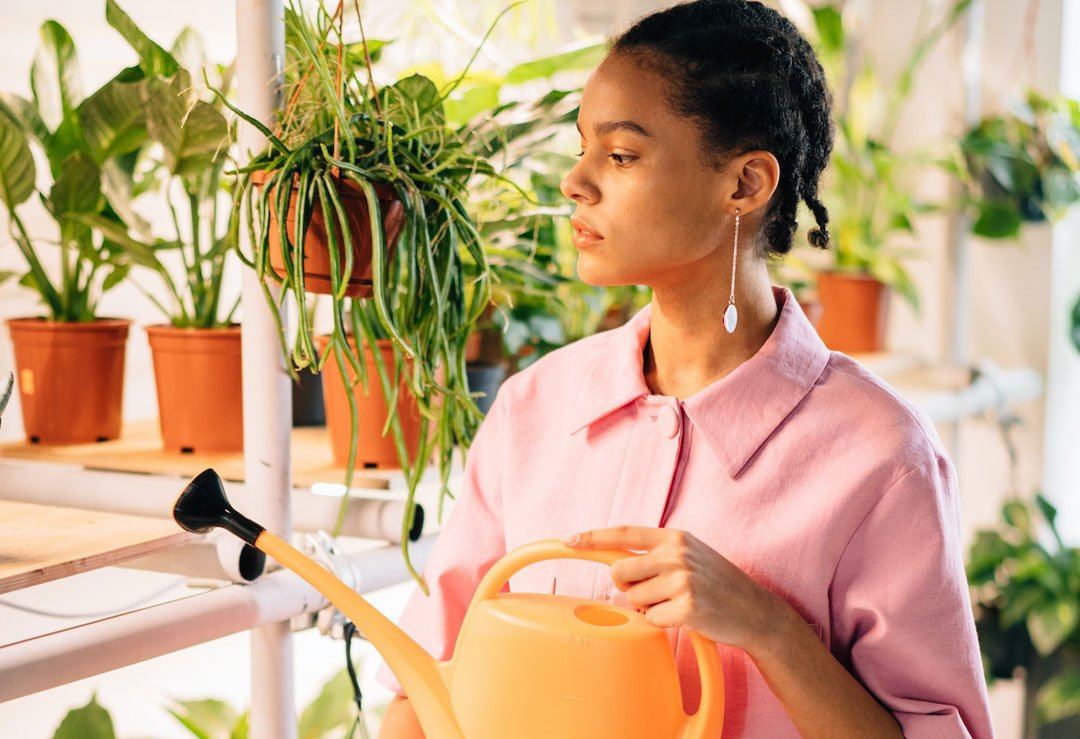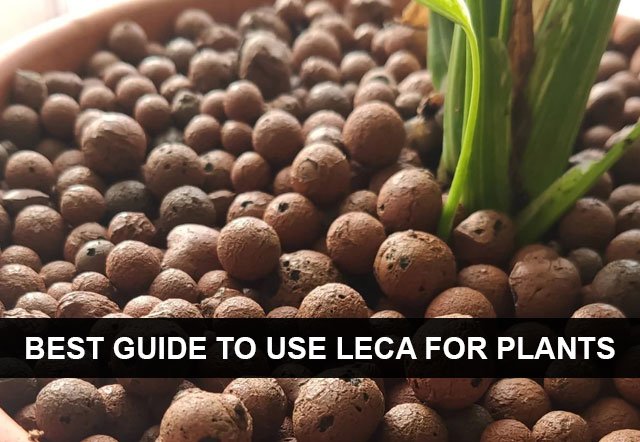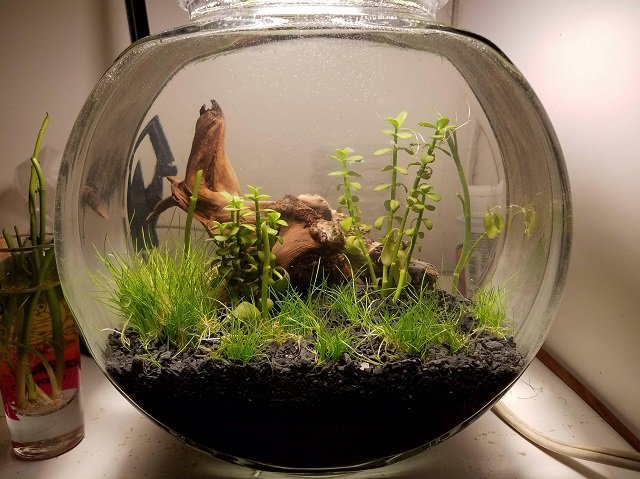If you have seen caudex plant in any garden or in any indoor place, you probably wondering how you can grow these plants because they look absolutely amazing in indoors and refreshes your interior with its fresh fragrance.
Caudex plants are also known as caudiciform plants. Most of the plants in this category have interesting names, which is quite interesting. They make fantastic indoor decorative plants because of their unique but lovely appearance. Succulents make up the majority of caudex species, although there are also bonsai, caudex trees, and vines. Some are of the grass and bulb varieties.
What are Caudex Plants?
Well, Caudex, which is Latin for “tree trunk,” refers to the axis of a woody plant, particularly a palm or tree fern, which consists of the stem and root. The plants are classified as Pachycauls, which is Greek for “thick stem” (where pachy refers to thickness and caulis to stem).
Caudex plants typically have enlarged or spreading stems or roots. This large or thick caudex stem or caudex root is never below the ground; either the stem or the root emerges above the surface. The plants are sometimes known as fat plants because of how they seem.
There is a reason why their roots are above the ground as this plant can withstand a rough period and then start growing swiftly when the weather improves because it has stored nutrients and water. Due to the way they deal with storage, caudex plants frequently coexist with succulents.
Thick leaves are a characteristic of succulents, and caudex plants contain a substantial center storage space. Frequently very delicate, the foliage is designed to only be present when conditions are favorable. Consequently, don’t be alarmed if your caudex plant is entirely naked for several months.
Most Common types of Caudex plants
1. Beaucarnea Ponytail Palm
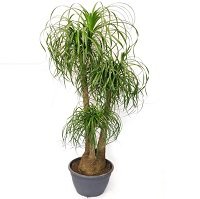
This type of Caudex plant is also known as Elephant Foot. One of the most popular evergreen indoor plant which has a large trunk. The ponytail-like development of curled leaves around the caudex of the elephant foot gave rise to the name Ponytail Palm.
Contrary to popular belief, ponytail palms are succulents. Succulents or palms bring a touch of the tropics and botanical interest to every room in your house.
If you want to add a lovely houseplant to your home without investing a lot of effort in caring for it, the ponytail palm plant is a great option. It may be grown as a bonsai and requires less water and light than palm trees.
Well, ponytail palms rarely bloom in indoors but, if you grow your ponytail palm outside, it will also generate flower stalks that may grow to a height of at least 16 feet. Clusters of tiny yellowish flowers will emerge in the summer if you plant it in your outdoor gardens.
If you want to get a quick overview about this plant, then checkout the following table.
| Common Name’s | Ponytail Palm, Elephant foot tree, Elephant foot palm |
| Botanical Name | Beaucarnea Recurvata |
| Origin | Mexico |
| Light | Direct bright light |
| Temperature | 6o to 7o degree F |
| Soil | Well-drained soil |
| Water | Average watering |
| Fertilizer | In Spring season |
| Toxicity | Non-toxic to pets and humans |
| Height | 10-20 ft |
Important facts to care Ponytail Palm
- Need of sunlight
Ponytail palms thrive in strong light since they are classified as desert plants. They can, however, endure moderate shade but will not develop as rapidly. When caring for a ponytail succulent, position it as close to a west or east-facing window where it will get enough of light. The ideal temperature for this plant ranges between 60 to 80-degree F but if the temperature is below 40-degree F, then this plant will not thrive properly.
- Watering
The root system of Ponytail Palm is much similar to cactus. They dig down to preserve water for dry seasons. Ponytail palms have a broad base that can retain water as well, keeping the soil wet. Every one to two weeks, give your palm a drink. Up to four weeks might pass before a drink is required. It will require more frequent watering if it is exposed to direct sunlight.
- Soil type
Well, ponytail palm in indoor doesn’t need any particular type of soil. You can use any specialized palm soil which will thrive your plant aggressively.
- Fertilizer
In the summer and spring season, you can add a liquid cactus fertilizer after every 2 to 4 weeks. Reduce fertilization to once every 1-2 months or so during the off seasons. Don’t over fertilize or fertilize your ponytail palm at the incorrect time, as this might generate ideal circumstances for diseases and pests.
2. Madagascar Palm Caudex Plant

Another classic caudex plant on the list is this one. It makes a beautiful home decoration plant. The tall, thin, tapering leaves of the Madagascar palm caudex envelop the stem. The Madagascar caudex has flowers that resemble frangipani blossoms.
The Madagascar palm, which may be recognized by its spear-shaped dark green leaf, has a single, strong, grey trunk that may also contain thorns. With tiny, 4-inch buds, the plant blooms every spring and until the beginning of the summer. The flowers are normally white but can also be seen in yellow, pink, or red.
When cultivated outside, the Madagascar palm may grow up to 24 feet tall, with a spiral of leaves at the top. When planted inside, it will grow significantly smaller, reaching a maximum height of 6 feet or fewer. The Madagascar palm takes a decade to grow, and it may take several years before your plant is ready to flower.
To get a quick overview, checkout the following table.
| Common Name’s | Madagascar Palm Plant, Madagascar palm cactus |
| Botanical Name | Pachypodium lamerei |
| Origin | Madagascar |
| Light | Likes indirect light |
| Temperature | 6o to 7o degree F |
| Soil | Well-drained soil |
| Water | Average watering |
| Fertilizer | In Spring season |
| Toxicity | Pachypodium lamerei |
| Height | 4-8 ft |
Important facts to care Madagascar Palm Caudex Plant
- Need of sunlight
This plant enjoys full sun, like the majority of succulents, although it can also survive in outside light shade. Place your Madagascar palm immediately next to a south or west-facing window if you intend to keep it indoors to ensure that it receives adequate sunshine. Rotate your plant to ensure that it gets an even distribution of sunshine; otherwise, the plant can become crooked as it strives for light on one side.
- Watering
In the spring and summer, let the soil to dry out in between watering. Unless examples are grown inside or in south Florida, where plants may retain their foliage, expect leaves to fall throughout the winter. Add extra water if the soil on the surface appears dry. Just enough water to keep dry or mesic soil wet. Once your Madagascar palm has grown, water it minimally, and even less during the winter.
- Soil type
Madagascar palm may grow in a wide range of well-drained soils. It thrives on the sandy soil of ancient dunes near the sea, as well as limestone and schists. Plant in cactus compost for the best results. Maintain a pH from 6.1 and 7.8 that is moderately acidic to slightly alkaline.
- Fertilizer
At the start of the summer and spring season, you can feed your plants with some houseplant liquid fertilizer so that your plant will grow more aggressively and healthily.
3. Euphorbia Stellata Caudex Plant
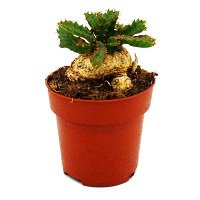
On the list of caudex plants, this is yet another popular type. Euphorbia caudex, often known as the Medusa’s head, has a large potato-like appearance. The Euphorbia Stellata plant is a stunning succulent with stems that emerge from a base. When the plant is fully grown, you may anticipate it to be around 15 cm (6′′) tall and 7.5 cm (3′′) in diameter.
This uncommon variety of succulent blooms in the spring. You may appreciate the green-yellow blossoms as they bloom. It makes a lovely addition to your plant collection, especially if you display it in a lovely container.
This plant requires a little pampering to grow in a healthy way. You just have to place it under a bright direct sunlight and try to water it after you see some dampness. However, these plants can survival for quite a long period of time if you even don’t bother to water them. In growing season, you can also add some half-strength fertilizer to bloom the growth of your indoor Euphorbia Stellata Caudex.
For getting quick overview, read the following table.
| Common Name’s | Medusa’s Head, Euphorbia Caudex |
| Botanical Name | Euphorbia Stellata Willd |
| Origin | South Africa |
| Light | Prefers direct sunlight |
| Temperature | 60 to 80 degree F |
| Soil | Well-drained soil |
| Water | Average watering |
| Fertilizer | In Summer and Spring season |
| Toxicity | Toxic to children’s and pets |
| Height | 6-inches |
Important facts to care Euphorbia Stellata Caudex Plant
- Need of sunlight
Full light is preferred by Euphorbia stellata plants above partial shade. They need intense light and exposure to the sun for at least six hours. Succulents of the species Euphorbia stellata should be grown indoors in an area that receives lots of light. The optimal location for the care of Euphorbia stellata is beside a sizable east-west facing window.
- Watering
When given proper care, Euphorbia Stellata may look pretty lovely. Similar to other succulent varieties, this one need routine watering. To maintain the health of your plant, the watering technique is crucial. There shouldn’t be any water left over, and it shouldn’t sit on the water. The soak and dry approach is the best way to hydrate this succulent. However, the succulent should be kept under control to prevent overwatering.
- Soil type
The succulent plant Euphorbia Stellata thrives in arid, permeable soils with adequate drainage. Cactus soil or any potting mix with a high sand content is excellent for these plants’ growth. You may also use some gravel, which can improve drainage.
- Fertilizer
It is not necessary to fertilize this plant frequently. Every month or so, you may fertilize it with a liquid fertilizer diluted to half its intensity. Avoid fertilizing in the heat since it can cause the leaves to burn and brown, which can cause permanent damage to your plant.
4. Rock Fig Caudex Plant

The Rock Fig Caudex is one of the most evergreen plant which belongs to Moraceae family. If you look at the foliage of the plant, you will see that they are made of soft leathery leaves with pink veins on the leaves. The shape of the leaves is oval and this plant can grow up to 2 meters in indoors.
If it is grown outside or in its natural habitat, it is a tree. The only conditions the plant needs are well-drained soil and some shade.
The common names for this plant are Rock Fig and Petiolate Fig. It grows well in bright partial shade and well-draining soil, making it a fantastic houseplant. This plant is favored for bonsai methods because the root may develop a characteristic woody caudex over time.
When cultivated in cultivation, it rarely produces flowers or fruits and prefers a soil with good drainage and some shade. Keep it tiny or go huge, plants frequently grow to the size of the container they are maintained in.
In pots, Rock Fig grows 1-8m tall and 1-5m broad. Adapted to the arid areas of the Northern Territory, they favor poor soils but will thrive in loamy, sandy loam, clay loam, or even commercial potting mix.
If you are a quick reader like me, check this table to get quick overview.
| Common Name’s | Petiolate Fig, Rock Fig |
| Botanical Name | Ficus Petiolaris |
| Origin | Oaxaca |
| Light | Prefers direct sunlight |
| Temperature | 60 to 80 degree F |
| Soil | Well-drained soil |
| Water | Average watering |
| Fertilizer | In Summer and Spring season |
| Toxicity | Toxic to humans and pets |
| Height | 20 to 30 ft |
Important facts to care Rocky Fig Caudex Plant
- Need of sunlight
This plant requires exposure to full sun to moderate shade and has a high heat tolerance. It can tolerate some shade but still thrives well in direct sunlight. So, if you want to grow this plant indoor, you have to place it where this plant gets most of sunlight.
- Watering
You should water it when you see some dryness on the top layer of sand. In the cold season, you should water more because the upper soil remains moist and you will not see any dryness. After 2 to 3 weeks, you can add water in winters but in summers, they need a little bit more water because the summer season is their growing season.
- Soil type
Rocky Fig prefers well-drained soil. A healthy soil will be rich in organic matter, such as coco coir, as well as perlite or vermiculite, which will aid in drainage. A handful of perlite added to standard store-bought potting soil should be enough.
- Fertilizer
You shouldn’t need to apply fertilizer as long as the potting soil is changed annually because it contains all the nutrients your plant need. Keep in mind that sunlight, not fertilizer, is what plants need to grow.
5. Begonia ParTita Caudex Plant
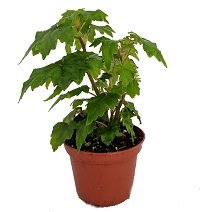
This caudex plant is originated in South Africa and is a member of the Begoniaceae family. The plant is around 35 cm tall, with a caudex thickness of about 10 cm. The plant’s common name is Maple Leaf Begonia.
The creeping growth pattern of the Maple leaf begonia produces a bushy plant with lovely thick red leaves that have light green patterns. The medium-growing, low-maintenance houseplant may mature to a size of up to 2 feet.
While accepting soil that contains some clay, loam, or silt and growing well in partial shade, begonia Parita Caudex need adequate drainage. The pH of the soil may fluctuate from acidic to neutral, and it can endure rarely dry soil.
However, to get a quick review, just look to the following table.
| Common Name’s | Maple Leaf Begonia, Wild Begonia, Grape-leaf Begonia |
| Botanical Name | Begonia Dregei |
| Origin | South Africa |
| Light | Prefers direct sunlight |
| Temperature | 70 to 85 degree F |
| Soil | Well-drained soil |
| Water | Average watering |
| Fertilizer | In Summer and Spring season |
| Toxicity | Toxic to humans and pets |
| Height | 2 to 5 ft. |
Important facts to care Begonia Parita Caudex plant
- Need of sunlight
All year long, Begonia Parita needs strong, filtered light. It is simple to grow in some shade. When growing plants on a window sill in direct sunlight, it is ideal to face the window south in the winter and east in the summer. This blooming Begonia will produce more leaves than flowers if it is placed in a location that receives a lot of shade.
- Watering
In contrast to other houseplants, it grows quickly and needs less water. It can require extra watering if you live somewhere with a dry environment. When the soil has dried, water the Begonia using the bottom watering technique. Providing the plant with too much water might result in root rot, which kills Begonia plants. Always water plants in a bowl or sink so that extra water may be quickly drained away.
- Soil type
The soil must contain the proper number of elements in order to produce a healthy plant. The development rate of your plant might be slowed if you do not have suitable and rich soil. This plant likes damp soil but not much soggy or loamy soil. So, try to add appropriate level of water to fulfil this need.
- Fertilizer
Feed your begonias with a regulated liquid fertilizer all summer long when they are in the active growth phase. Of course, consistent fertilizer during the growth season will encourage higher bloom, especially for potted plants. Applying fertilizer straight to foliage should be avoided since powerful fertilizers might harm your plant’s stem and leaves.
6. Desert Rose Caudex Plant
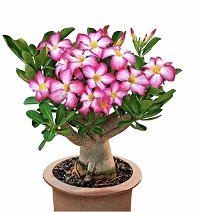
Desert Rose Caudex is one of the most loved specie of Caudex which belongs to Apocynaceae family and mostly found in Sahara Desert. It is a slow-growing plant with a thick succulent trunk. The foliage is made up of thin leaves, but the major draw is the gorgeous pink blossoms.
Depending on where you live, desert rose can be grown indoors or outdoors. It is a popular decorative outdoor plant in many tropical and warmer areas, and it is cultivated indoors in cooler climes. It grows best in the spring and dies if exposed to frost or cold weather.
Although maintaining a desert rose plant is straightforward, it does require some skill. It needs plenty of sunshine and careful water management, just like other succulent plants.
The following table will help you to get the quick overview about this Caudex plant type.
| Common Name’s | Desert Rose, Sabi star, Impala Lili |
| Botanical Name | Adenium Obesum |
| Origin | Arabian Peninsula |
| Light | Prefers direct sunlight |
| Temperature | 60 to 85 degree F |
| Soil | Well-drained soil |
| Water | Average watering |
| Fertilizer | In Summer and Spring season |
| Toxicity | Toxic to humans and pets |
| Height | 1-3 m |
Important facts to care Desert Rose Caudex Plant
- Need of sunlight
In a setting with direct sunlight, the desert rose flourishes. Select a location in your house that will provide the plant with enough of light throughout the day, such as a sunny window that faces south or a sunroom.
- Watering
Depending on the season and weather, the water needs of the desert rose plant might change. Keep its soil damp but never soggy during the growth season. Periodically inspect the soil, and don’t water it until it’s fully dry. A container with lots of drainage holes is also recommended for planting your desert rose.
- Soil type
The desert rose plant is adapted to naturally dry, desert-like environments, i.e., sandy or gravelly cactus soil that drains effectively. The pH of the soil should range from neutral to acidic, ideally staying close to 6.0.
- Fertilizer
If you want to get more flowering for desert rose, you have to add liquid fertilizer in its growing season. Don’t use fertilizer in winter season because if you do so, then your plant may get damage due to overflow of nutrients.
7. Fockea Edulis Caudex Plant

The most common name of Fockea Edulis is Hottentot bread, a member of the Asclepiadaceae family, is originated from South Africa. The caudex may reach a height of 4 meters and a thickness of around 60 cm. When it blooms, it produces white flowers.
According to local lore, the caudex is tasty. It has a large caudex with one set of branches that resemble vines and another set that resembles trees.
From the tip of its stem, this caudiciform succulent develops long, creeping branches. In the winter, it usually becomes dormant, and in the summer, it produces frilly green leaves. At the latter end of summer, it blooms with green to green-white flowers.
In cultivation, the caudex is beautiful and is typically developed above ground, although in nature it is buried farther into the earth. These plants make great succulent bonsai and, given the right care, may grow very large.
Here are some quick specs about this type of Caudex plant.
| Common Name’s | Hottentot Bread |
| Botanical Name | Fockea edulis |
| Origin | South Africa |
| Light | Prefers full sunlight to partial shades |
| Temperature | 60 to 85 degree F |
| Soil | Well-drained soil |
| Water | Average watering |
| Fertilizer | In Summer and Spring season |
| Toxicity | Toxic to cats and dogs |
| Height | 6 to 12 ft |
Important facts to care Fockea Edulis Caudex plant
- Need of sunlight
Strong light is required by Fockea Edulis. Make sure this variety of succulent receives sunshine when you put it in a garden. For its development, full to partial light is preferable. Growing outside is preferable to inside.
- Watering
Similar to other succulent varieties, this one need routine watering. The watering technique is crucial to maintaining the health of your Fockea Edulis. There shouldn’t be any water left over, and it shouldn’t sit on the water. The soak and dry approach is the best way to hydrate this succulent. However, the succulent should be kept under control to prevent overwatering.
- Soil type
Well, you can use fast-draining soil to propagate your Fockea as it will help to drain the excess of water from your plant.
- Fertilizer
During the growing season, you can add high-nitrogen liquid fertilizer to boost the growth of your Fockea Edulis caudex. Don’t use fertilizers during winter season because it can affect the growth and color for your indoor plant.
8. Buddha Belly Caudex plant
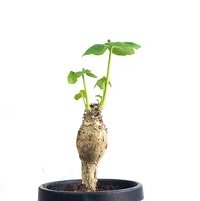
In tropical settings, Buddha belly plants thrive. They are unusual plants whose spherical, swollen bellies resemble certain images of Buddha, and they got their name as a result. The plant originates from the tropical Americas and is classified as a shrub.
The bottle-shaped, knobby, gray-skinned caudex grows upright and gets narrower toward the top. The top of the plant produces new leaves. The male and female flowers are present in the orangish-red flower clusters, which are held above the leaves. It will occasionally bloom throughout the majority of the year, even in the dead of winter.
Most of the people likes to grow this plant in indoors but if you grow it in outdoors, it will thrive more eagerly up to 5 feet’s. Although they are toxic and should be handled carefully, Buddha belly plants are a wonderful aesthetic addition to any indoor. Buddha belly plants need the right care, just like any other plant, to survive and grow in their surroundings.
Here are some main specs to know about this Caudex plant.
| Common Name’s | Bottle plant shrub, Buddha Belly, Gout plant, Purging nut |
| Botanical Name | Jatropha podagrica |
| Origin | Tropical Americas |
| Light | Prefers full sunlight to partial shades |
| Temperature | Above 15 ºC |
| Soil | Well-drained soil |
| Water | Average watering |
| Fertilizer | In Summer and Spring season |
| Toxicity | Toxic to humans and pets |
| Height | 2 to 3 ft. |
Important facts to care Buddha Belly Caudex plant
- Need of sunlight
Buddha belly plants need a lot of sunlight, especially if they are being grown inside, but excess of direct sunlight can damage the leaves by burning them. It should work if you place the Buddha belly plant close to a south-facing window. In order to prevent the leaves from overheating, you must rotate the plant frequently throughout the year.
- Soil type
The Buddha belly plant may grow in poor soil, but it loves soil that has a pH between 5.6 and 7.3, which is either moderately acidic, slightly acidic, or neutral. If you’re unsure of what kind of soil to purchase from the garden centre, the Buddha belly plant also thrives in cactus soil.
- Watering
As we all know that no plant will thrive properly if you don’t pour sufficient water in it but in the case of this plant, you don’t have to pour much water because this plant is a drought-tolerable cactus specie which can survive without water for quite a long period of time. It only needs to be watered once or twice per week. Be careful not to overwater it.
- Fertilizer
The Buddha belly plant may grow healthy and to its maximum potential by adding fertilizer. You may start fertilizing whenever you start to see your plant is becoming dull and dry. Continue fertilizing once a month during the spring and summer active growing seasons. you can use liquid fertilizers in this type of caudex plant.
How to Take Care of Plants with a Caudex?
The majority of caudex plant varieties are low-maintenance and simple to maintain. The primary things to watch out for are as follows:
- Water:
In the growing season like summer and spring, most type of Caudex plants need constant watering. As is customary with succulents, you must make sure the soil is completely dry in between watering’s. Watering should be kept to a minimum throughout the winter or in inactive growth season.
- Soil:
In some types of Caudex, you need loamy or moist soil otherwise, cactus soil potting is ideal for every type of caudex plant.
- Sunlight:
Well, caudex plant enjoys full shade of sunlight but some types of caudex like to thrive in a little partial shades.
- Temperature:
The majority of these succulents demand a summer environment with good ventilation because they are not frost-hardy. So, place it according to their need and you’ll see a blooming caudex within months.
- Propagation:
To propagate caudex, the best way is to use seed. You can also use cuttings to propagate different types of caudex plants.
Conclusions
If you are planning to harvest or propagate Caudex plant in your indoors or outdoors, then you must consider all the facts given in this guide of Caudex plant. This plant will definitely bloom your interior and exterior but if you have pets in your home, then try to place them in such spot where your pets can’t reach because most of the Caudex types are toxic to pets.
I hope this guide will help you to select the best caudex plant for your indoors and outdoors. If you have some queries, you can for sure ask in the comments section.

